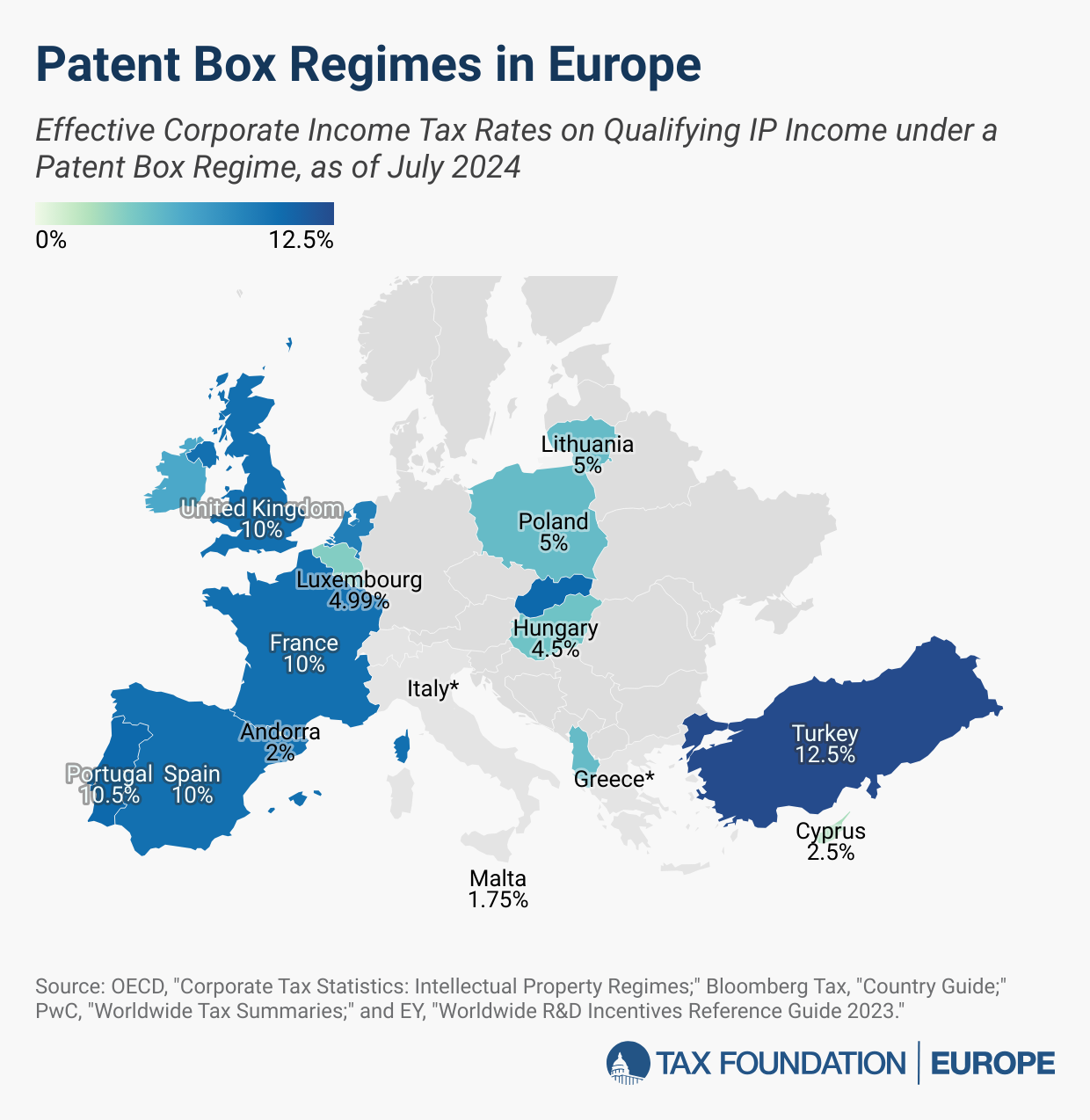Products You May Like
Patent boxA patent box—also referred to as intellectual property (IP) regime—taxes business income earned from IP at a rate below the statutory corporate income tax rate, aiming to encourage local research and development. Many patent boxes around the world have undergone substantial reforms due to profit shifting concerns.
regimes (also referred to as intellectual property, or IP, regimes) provide lower effective taxA tax is a mandatory payment or charge collected by local, state, and national governments from individuals or businesses to cover the costs of general government services, goods, and activities.
rates on income derived from IP. Most commonly, eligible types of IP are patents and software copyrights. Depending on the patent box regime, income derived from IP can include royalties, licensing fees, gains on the sale of IP, sales of goods and services incorporating IP, and patent infringement damage awards.
The aim of patent boxes is generally to encourage and attract local research and development (R&D) and to incentivize businesses to locate IP in the country. However, patent boxes can introduce another level of complexity to a tax system, and some recent research questions whether patent boxes are actually effective in driving innovation.
As today’s map shows, patent box regimes are relatively widespread in Europe. Most have been implemented within the last two decades.
Currently, 13 of the 27 EU Member States have a patent box regime in place. These are Belgium, Cyprus, France, Hungary, Ireland, Lithuania, Luxembourg, Malta, the Netherlands, Poland, Portugal, Slovakia, and Spain (federal, Basque Country, and Navarra). Non-EU countries Albania, Serbia, Switzerland, Turkey, and the United Kingdom have also implemented patent box regimes.
The reduced tax rates provided under patent box regimes range from 1.75 percent in Malta to 12.5 percent in Turkey.
For comparison, the United States applies a preferential tax rate of 13.125 percent (instead of the 21 percent federal corporate income taxA corporate income tax (CIT) is levied by federal and state governments on business profits. Many companies are not subject to the CIT because they are taxed as pass-through businesses, with income reportable under the individual income tax.
rate) on foreign-derived intangible income (FDII), i.e., business income from exports related to intellectual property. The FDII rate is set to increase to 16.4 percent in 2025.
In recent years, several European countries have repealed their patent boxes. Andorra phased out its patent box from 2018 to 2020. Italy repealed its patent box in 2021 and instead introduced a deduction for 230 percent of costs related to research and development. This represents a transition away from a benefit based on income (the patent box) to a benefit focused on investment or expenditure (the super-deductionA super-deduction is a tax deduction that permits businesses to deduct more than 100 percent of their eligible expenses from their taxable income. As such, the super-deduction is effectively a subsidy for certain costs. This policy sometimes applies to capital costs or research and development (R&D) spending.
). San Marino comes in as the most recent country in Europe to repeal both of its IP regimes in 2022.
In contrast, Portugal increased its corporate income tax exemptionA tax exemption excludes certain income, revenue, or even taxpayers from tax altogether. For example, nonprofits that fulfill certain requirements are granted tax-exempt status by the Internal Revenue Service (IRS), preventing them from having to pay income tax.
for patent income from 50 to 85 percent in 2022.
In 2015, OECD countries agreed on a so-called Modified Nexus Approach for IP regimes as part of Action 5 of the OECD’s Base Erosion and Profit ShiftingProfit shifting is when multinational companies reduce their tax burden by moving the location of their profits from high-tax countries to low-tax jurisdictions and tax havens.
(BEPS) Action Plan. This Modified Nexus Approach limits the scope of qualifying IP assets and requires a geographic link among R&D expenditures, IP assets, and IP income. To be in line with this approach, previously noncompliant countries have either abolished or amended their patent box regimes within the last few years.
Many European countries offer additional R&D incentives, such as direct government support, R&D tax credits, or accelerated depreciationDepreciation is a measurement of the “useful life” of a business asset, such as machinery or a factory, to determine the multiyear period over which the cost of that asset can be deducted from taxable income. Instead of allowing businesses to deduct the cost of investments immediately (i.e., full expensing), depreciation requires deductions to be taken over time, reducing their value and discouraging investment.
on R&D assets. The effective tax rates on IP income can therefore be lower than the ones stated in the respective patent box regimes.
Stay informed on the tax policies impacting you.
Subscribe to get insights from our trusted experts delivered straight to your inbox.
Share
Previous Versions
-
Patent Box Regimes in Europe, 2023
3 min read
-
Patent Box Regimes in Europe, 2022
3 min read
-
Patent Box Regimes in Europe, 2021
4 min read
-
Patent Box Regimes in Europe, 2020
4 min read
-
Patent Box Regimes in Europe, 2019
4 min read
